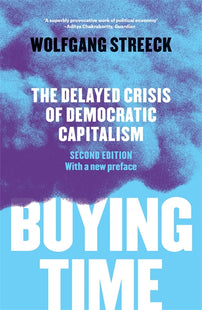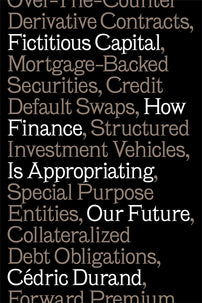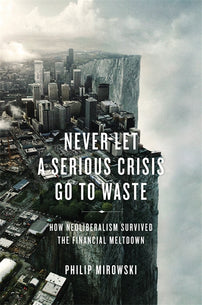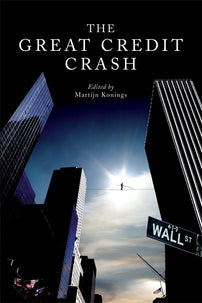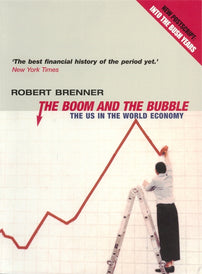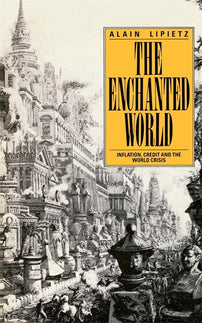Are We Heading for Another Economic Crash?
Responses from Wolfgang Streeck, Cédric Durand, Susan Newman, David M. Kotz, Mingqi Li, Mary Mellor, Andrew Ross, Tim Di Muzio, Dario Azzellini, Ying Chen, Richard Murphy, Michael Roberts, Lena Rethel, and Heikki Patomäki.

This article was first published by State of Nature, as part of the monthly "One Question" series, which solicits responses to a single query from a variety of thinkers. This month's question — "Are we heading for another economic crash?" — received responses from Wolfgang Streeck, Cédric Durand, Susan Newman, David M. Kotz, Mingqi Li, Mary Mellor, Andrew Ross, Tim Di Muzio, Dario Azzellini, Ying Chen, Richard Murphy, Michael Roberts, Lena Rethel, and Heikki Patomäki.
Wolfgang Streeck
Professor emeritus of sociology. From 1995 to 2014 he was Director at the Max Planck Institute for the Study of Societies in Cologne, Germany. His latest book is How Will Capitalism End? Essays on a Failing System (Verso, 2016).
I’m not a prophet. But there is no capitalism without the occasional crash, so if you will we are always heading for one. Inflation in the 1970s was ended by a return to "sound money" in 1980, which begot deindustrialization and high unemployment, which together with tax cuts for the rich begot high public debt. When public debt became too high, fiscal consolidation in the 1990s had to be compensated, for macro-economic as well as political reasons, by capital market deregulation and private household debt, which begot the crash of 2008.
Now, almost a decade later, public debt is higher than ever, so is private debt; the global money volume has been steadily increasing for decades now; and the central banks are producing money as though there was no tomorrow, by buying up all sorts of debt with cash made ‘out of thin air’, which is called Quantitative Easing. While everybody knows that this cannot go on forever, nobody knows how to end it — same with public and private debt, same with the money supply. Something is going to happen, presumably soon, and it is not going to be pleasant.
Cédric Durand
Associate professor in Economics the University of Paris Cite and the author of Fictitious Capital: How Finance Is Appropriating Our Future (Verso, 2017).
The illusion that financial assets can create value "as it is the property of pear-trees to bear pears" is nowadays much more vivid than in Marx’s times. This fetishisation of finance and its empowerment are the reasons why, after 2008, the main avenue to roll back the danger of a debt-deflation spiral was a huge monetary stimulus. As acknowledged by Claudio Borio, a prominent figure at the Bank of International Settlement, rich economies became addicted to low interest rates and central bankers have dramatically increased the dose in the past few years with near zero or even below zero key interest rates and assets purchase programs.
The outcome of this sequence is an outrageously unsustainable dynamic: on the one hand, financial fragility is on the rise again, in particular with excessive corporate debt in the US, persistent bank fragility in Europe, and overvalued stock markets. In the real economy, this monetary stimulus has not delivered much: growth rates are anaemic, underemployment endemic, productivity sluggish and investment hardly sufficient to prevent a productive involution throughout the developed world.
It seems, then, that there is no recovery but only a renewed financial assertiveness backed by highly biased policies. The elementary forms of finance capital — stock-market capitalization, credit to the private non-financial sector, and public debt — now represent more than 350% of GDP on average in the major high-income countries compared to 150% in the early eighties, and 330% before the crisis. In order to be sustained, the value of these financial claims require that the expected financial incomes fall in due time: debt must be honoured, interests paid, dividends disbursed.
But how can that be in stagnating economies? The first possibility is just ponziying further: as more debt floods in, everything moves smoothly. But this puts central banks in a deadlock. If they move back to more usual monetary policies, they will trigger a recession and increasing financial distress. The fact that long-term interest rates in the US are still trending downward in spite of recent Federal Reserve rises indicate that markets do not believe in a normalisation of monetary policy. However, if central bankers do not move forward, financial imbalances will continue to build up, favouring misallocation of resources and increasing the amplitude of the next crash. Financial hegemony was able to survive a few additional years in intensive care — but now is the time to say farewell.
The next crash won’t be a repetition of 2008: this time the credibility of central banks will be at stake, with the risk of a full blown monetary crisis. In preparation of this predictable unfolding of events, it should already be clear that private finance ought not be saved again, that delirious financial claims of the wealthiest over the work of the rest of us won’t be validated anymore by government intervention. Instead, it’s time to bring to the front of the agenda the socialization of the banks, debt jubilee, universal pension, education and healthcare systems, ecological investment planning and open data. Freeing our societies from the financial time-bond will require a new ability to engineer the future.
Susan Newman
Senior Lecturer in Economics at the University of the West of England where she leads the MSc program in Global Political Economy.
We are heading for another economic crash because the underlying conditions that brought about the financial crisis of 2007-8 remain. The post-crisis slump saw the restructuring of capital, aided by government and central bank policies, in order to restore profitability and the incomes and wealth of the 1% premised upon fictitious accumulation.
Speculative finance continues to dominate economic activities in the advanced capitalist economies. Corporate profits, personal wealth, pension provision and food prices, continue to be tied to the vagaries of finance. The IMF’s growth projections for 2018 recognise that modest growth will be driven by financial markets with little impact on real investment, job creation, productivity or wages. Stock market capitalisation to GDP ratio is higher than at any time except for the eve of the dot.com bust in 2000 indicating the disconnection between financial investment and productive activities. In spite of Basel III, the financial system continues to be characterised by high leveraging and global interconnectedness owing to the rise of the shadow banking system.
Austerity in the UK since 2010 has created new trigger points for crises. Personal debt in the UK has reached alarming and unsustainable levels in excess of £200bn. Welfare cuts, stagnant wages, and the deterioration of employment contracts has meant that low income families in the UK have had to borrow for basic day to day expenditures. One can expect many more cracks in the system in which the next crisis will emerge. However, rather than trying to predict the timing or origins of impending crises, efforts would be more productively oriented towards radical change of the economic system. Reforms such as those that supported the Golden Age could help temper some of the deadliest side effects of capitalist growth. But in the long run we need to treat those side effects as the main goals for society: for each of us to reach our full potential and live in material comfort free from alienation from each other and our environment.
David M. Kotz
Economics professor at the University of Massachusetts Amherst and the author of The Rise and Fall of Neoliberal Capitalism (Harvard University Press, 2015).
Yes and no. That is, a recession is likely to begin in the US in the not too distant future. However, the preconditions for the kind of severe crash we saw unfold in 2008-09 are not present today.
Economic conditions in the US today bear some similarities to the mid-2000s. Income and wealth inequality are still in the stratosphere. The Trump Administration has initiated another round of bank deregulation. However, these similarities are not enough to bring another major crash.
The financial crisis and Great Recession of 2008-09 were caused by three unsustainable trends set off by the neoliberal form of capitalism: a giant asset price bubble (in real estate) that had to collapse, the spread of bound-to-fail derivative securities throughout the US financial system and much of the global financial system, and an unsustainable build-up in household debt that had underpinned growth in consumer spending.
After the crash, the Federal Reserve unburdened the banks of their failed derivative securities. Household debt declined relative to household income after 2009 and has stabilized at a safe level since 2015. And while US stock prices have been rising, this does not have the hallmarks of a self-perpetuating, about-to-collapse bubble — the S&P 500 price-earnings ratio, which rose steadily for four years after 2011, has since stabilized at a level far below that of the stock bubble of the late 1990s.
However, a more typical recession is likely to begin in the near future, with its costs in rising unemployment, small business failures, and a squeeze on state and local revenues and services. The current US economic expansion is now 10 years old, and every expansion in capitalism eventually ends in recession. The rate of profit on invested capital of the nonfinancial corporate business sector, while high, has been falling since 2014, which usually indicates a coming recession. However, the big economic problem today is the long-term stagnation that has afflicted the US economy and much of the global capitalist system since the Great Recession ended in 2009, causing much economic suffering and destabilizing political systems around the world.
Minqi Li
Professor of economics at the University of Utah. His recent books include The Rise of China and the Demise of the Capitalist World Economy (Monthly Review, 2009), Peak Oil, Climate Change, and the Limits to China’s Economic Growth (Routledge, 2014), and China and the Twenty-first Century Crisis (Pluto, 2015).
The answer to this question partly depends on what one means by "economic crash." If one means one of those "normal" recessions that happen to the global capitalist economy once in every several years, then almost certainly we will see such a recession in the next two or three years.
The more interesting question is how severe the next recession will be. Since the "Great Recession" of 2008-2009, the core countries of the capitalist world system have struggled with persistent stagnation. On the other hand, household debt in the US has fallen to relatively normal levels and currently there is not an obviously large financial imbalance between the US and the rest of the world. From a purely technical point of view, the next global recession around 2020 may not be as severe as the last one.
Far more important is what has happened in China. China’s industrialization has transformed its social structure and produced a large, 19th-century-style industrial working class. As this working class begins to organize and demand economic and social rights, its growing power has contributed to a falling profit rate in the Chinese economy. This is similar to what happened to the western capitalist economies in the 1970s and is something that no major economy has seen since then. It will be interesting to see whether this development will lead to a fundamental transformation of labor-capital relations of forces not only in China but also in the entire world system by the 2020s.
Whatever will happen in terms of an "economic crash," the capitalist world continues to head relentlessly towards the climate crash threatening to end civilization, as we know it. It is up to the global class struggle in the coming decades to determine whether the capitalist juggernaut can be stopped before it is too late.
Mary Mellor
Emeritus Professor in the Department of Social Science, Northumbria University, UK. Her recent books include The Future of Money: From Financial Crisis to Public Resource (Pluto, 2010) and Debt or Democracy: Public Money for Sustainability and Social Justice (Pluto, 2015).
If this refers to the financial sector, another crash will occur because nothing has been done to deal with the underlying contradictions of a debt-fuelled main street and a hot money financial casino. Signs of instability and "irrational exuberance" are driving unsustainable speculation, such as in Bitcoin. Household and personal debt is rising. It was speculation in household debt that triggered the 2008 crisis and the position is equally bad now, if not worse, as people have even less financial resilience.
However, my concern is the crisis of social justice and ecological sustainability in the economy of provisioning: providing the essential goods and services that create wellth, the well-being of people and the planet. Ecologically, we may be past the point of no return: global warming; plastic contaminants; drastic decline in insect numbers.
The crisis in social justice is tearing our societies apart. Far from bringing universal wealth or wellth, globalised capitalism has hollowed out communities in the older economies, while exploiting cheap labour in the newer ones. The cries of pain from those in "left behind" communities in both the old and new economies are producing populist and authoritarian leaders.
Market fundamentalism is also destroying the wealth of the public economy. Welfare states can no longer achieve their aim of caring for people from cradle to grave. Neoliberal "handbag economics" is ideologically opposed to publicly funded infrastructure and services. The state is seen as equivalent to a household, dependent on private sector funding. Austerity programmes aim to shrink the public sector to the level that the private sector is willing to sustain. This is compounded by tax avoidance and evasion and militant offshoring.
This ignores the role of state created "sovereign" money. The public rescue of private finance through quantitative easing reveals that new public money can be created at will. If public money can be created to fund the financial sector it can be used to fund the people, so that wellth, social justice and ecological sustainability becomes the priority of both public and private economies
Andrew Ross
Social activist and Professor of Social and Cultural Analysis at NYU. He is the author of many books, including Creditocracy and the Case for Debt Refusal, Bird On Fire: Lessons from the World’s Least Sustainable City (OR Books, 2014), and Nice Work if You Can Get It: Life and Labor in Precarious Times (NYU, 2010).
In 2007, the landmark Stern Report described "climate change" as "the greatest market failure that the world has seen." In some quarters, this observation was taken as a challenge for capitalists to do better, rather than as an indictment of a price system whose dependence on growth had produced its inevitable outcome in planetary environmental collapse. The steady deterioration of biospheric life is now so normalized that many battle-hardened activists pray for the next climate-driven catastrophe simply to call attention to their zero-carbon cause.
The widespread distress that follows a periodic economic crash can feel as if it occurs in a parallel universe, disconnected from melting polar caps and species die-offs, but these respective disaster zones have the same root causes in a crisis-prone economic system. The recent rise in high-risk financial speculation has only sharpened the tendency, as garden-variety Marxists would say, to resolve capitalism’s internal contradictions through episodic wipe-outs. The standard euphemism for this boom-and-bust is "the business cycle," as if to suggest there is some rational conduct driving the "animal spirits" of investors.
As ever, fortunes can be conjured out of estimating when and where the next crash will occur. Which bubble will burst first, triggering the collapse? Bitcoin? China’s property market? U.S. Treasuries? High-Yield Euro Bonds? Student loans? Take your pick. The only silver lining is that the ruinous aftermath offers a chance, as it did after 2008, to build that zero-carbon economy, along with plenty of sustainable green-collar jobs. If you really need to pray for something, that would fit the bill.
Tim Di Muzio
Associate Professor in International Relations and Political Economy at the University of Wollongong, Australia. He is most recently the author of The Tragedy of Human Development (Rowman & Littlefield, 2017).
The short answer is yes. However, the big question has to do with timing and how the crash will be experienced and by whom. Typically, an economic crash means that the value of owned income-generating assets like stocks (shares in companies) are radically devalued. For instance, at the height of the Global Financial Crisis, the market capitalization of all listed firms stood just above US$60 trillion and within a few months that was cut roughly in half. The crisis was of course related to the housing market in the United States as everyone knows, but it was far broader in its reach since it led investors to suspect that the banks would freeze credit in a time of record high oil prices. And in a capitalist economy, where the money supply increases by the extension of credit/debt to businesses and individuals, lack of faith in the expansion of credit is a real killer of expected future earnings.
There will likely be another stock market devaluation in the future caused by a fear of lesser future expected earnings, but the upcoming crisis that will shake capitalism to its core relates to three factors. First, we have about 50 years of oil left at current production rates according to BP. So we can expect oil prices to eventually go through the roof, and since oil goes into everything from computers to gasoline, we can expect an unprecedented inflation. Second, capitalism is a cost-plus accounting system (as long noticed by C.H. Douglas) which means there is never enough purchasing power in the economy for the outstanding prices of goods and services — hence the need for credit. This gap is structural and mathematical and cannot be overcome internally. Third, in an uncertain inflationary environment, the extension of credit (new money) will be frozen or come at ever increasing interest rates, only serving to exacerbate inflation.
Predictions are notoriously wrong but I care less about the exact timing of the next crisis and choose to focus on the three factors that will lead to the clusterfuck ahead: the price of oil, the nature of capitalist accounting, and the way in which new money is produced.
Dario Azzellini
Visiting research fellow at the ILR School, Cornell University (Ithaca). Recent publications include Communes and Workers’ Control in Venezuela: Building 21st Century Socialism from Below (Brill, 2017) and An Alternative Labour History: Worker Control and Workplace Democracy (edited, Zed Books, 2015). Together with Oliver Ressler he is producing Occupy, Resist, Produce, a series of documentaries on recuperated factories under workers control in Europe. More information: www.azzellini.net
No doubt we are heading for another economic crash because capitalism is always heading for another economic crash. It is the nature of capitalism to increase surplus capital and then destroy it again through a crash or war, in order to restart the accumulation process once again. After every crisis, as historical data shows, the rich get richer and capital concentration grows. The cycles from crash to crash are becoming shorter as the accumulation of surplus capital becomes faster.
There are two developments making an economic crash in the near future very likely. Similar to the time leading up to the 2008 crisis, there is again a looming private loan subprime crisis. Since the last crisis, banks (especially in the US and UK) have not changed their behavior. In the US alone subprime private auto loans in the order of US$26 billion exist. This is happening in the light of the longer lasting structural problem that capital cannot be reinvested in a materially productive way. That is why e.g. Uber, which is only producing financial loss, was worth an estimate US$ 48billion in December 2017 (down from US$68 billion a couple of weeks earlier!) or bitcoin had a vertiginous growth in value.
How disastrous the crash will be, will depend on the extent to which a subprime loan crisis will also trigger the burst of the bubble created by casino capitalist adventures. The destruction not only of the middle class, but also more generally most people’s ability to satisfy their basic needs, is a worldwide reality. Nevertheless, the US has abolished most social anchors and has fewer financial control mechanisms than other countries. It is therefore very likely that the next crash will emanate from the US, and/or the UK (especially considering Brexit).
Ying Chen
Assistant professor of Economics at the New School for Social Research. Her current research focuses on the sustainable development in contemporary China from the perspective of social, economic, and environmental sustainability.
Actually, we have hardly walked out of the last recession completely yet. In Europe, growth since last year was only experienced by the strongest economies such as Germany and the Netherlands. People in hard-hit countries such as Greece and Italy are still suffering from unemployment and austerity measures in the aftermath of the last crisis. In the USA, where the financial crisis started, the labour force participation rate remains 4 percentage points below the pre-crisis level. This suggests a dismal picture of more working-age people who either cannot find jobs or are discouraged from looking for jobs.
On the other hand, China, the country whose growth accounts for more than 30% of global economic growth, is now experiencing a declining profit rate and soaring debt-GDP ratio. The former could lead to slow investment and economic crisis while the latter could lead to a financial crisis. Either way, China’s crisis will have tremendous world economy implications given its almost 20% share of world GDP.
The recovery has not only been uneven but is also hardly sustainable if private investment remains so sluggish. This is what economists have been worried about: that despite some temporary stimulus-driven recovery, the advanced capitalist countries are indeed entering secular stagnation. When growth stagnates, the growing population and productivity, if any, will not be absorbed into the economy, resulting in unemployment and aggravating inequality. Capitalism was more progressive than feudalism because capitalists invest out of capital which leads to economic growth. It will lose its legitimacy as a system if investment stops. And to make it worse, central bankers are expressing concerns that monetary policy would be of very limited effectiveness and fiscal policy of little political feasibility for the next economic downturn. The next round of economic crisis in capitalist countries will breed a much more severe political crisis.
Richard Murphy
Professor of Practice in International Political Economy, City, University of London. He is also a chartered accountant, and tax reform campaigner. He blogs at Tax Research UK: http://www.taxresearch.org.uk/Blog/
The answer to this question has to be yes: capitalism is built on the concept of failure and so crashes are inevitable. The real question is how soon before the next crash?
My answer is soon. The reasons are multifold. It could be a hard Brexit creating a liquidity crisis for companies as lorries queue at ports meaning that businesses will fail as they run out of stock, orders and cash. Or it could be over-valued stock markets crashing, especially if central banks try (foolishly) to increase interest rates and trigger a household debt crisis at the same time. Alternatively it could be Chinese debt collapsing. Or (heaven forbid) Trump pushing his "big button." And it might be something else entirely.
The fact is economies historically do downturns. We are overdue for one. That would not be too worrying except that austerity and a failure to address most of the failings in financial capitalism that led to 2008 have left us hopelessly ill-prepared for the next crunch. And that’s why it will be a crisis and not a manageable bump.
Michael Roberts
Marxist economist who has worked in the City of London for over 30 years. He is author of two books: The Great Recession: A Marxist View (Lulu,2009) and The Long Depression (Haymarket, 2016). He blogs at thenextrecession.wordpress.com.
Yes, we are. There has been a slump in production and investment of varying degrees every 8 to 10 years since 1945. Such a regular and recurrent cycle is endemic to a capitalist economy (production and investment for profit) and the current cycle since the end of the Great Recession in 2009 is now over eight years long, the third longest in the last 70 years.
The economic crash may not happen in 2018 because corporate profits are still rising in most major economies and growth has picked up in Europe and Japan — but it will happen before the end of the decade at the latest.
What could happen in 2018 is a stock market crash as stock prices are very high compared to the earnings that companies in the US, Europe and Japan are generating to justify them. Cheap borrowing costs (low interest rates) are coming to an end as central banks globally start to reverse their easy credit schemes and raise interest rates.
The form of an economic crisis is always financial but the underlying cause is not. Profitability and profits in the productive sectors of the economy are the key drivers. The crisis is likely to start in the US, as this economy remains the largest and most financial. And this time the economic downturn will start in the corporate sector where debt continues to rise. Corporate profits may be rising but the profitability of each unit of investment is falling. And debt servicing costs will rise as central banks hike interest rates.
Lena Rethel
Associate Professor of International Political Economy at the University of Warwick and Visiting Fellow at the Oxford Centre for Islamic Studies. Author of The Problem with Banks, with Timothy J. Sinclair (Zed Books, 2012). Lena is a member of the I-PEEL: the International Political Economy of Everyday Life pedagogic initiative.
The short answer to this question is: Yes. From a UK perspective, it seems as if little has substantively changed in the decade since the last crisis. Current household debt is once more approaching levels last seen at the onset of the crisis of 2007-2009. Levels of personal loans and student debt — important markers of indebtedness as, unlike mortgages, they are not directly matched by ownership of an asset — have seen a steep rise in recent years. Without trying to be overly gloomy, it is fair to say that the question is not if another crisis will happen, but when it will happen and who will suffer most from the fallout.
Indeed, it is important to recognise that the economy has been crashing for many for quite some time now. Over the last decade, income inequality has changed little and wealth inequality has effectively increased in the UK. So has the number of homeless people and of those dependent on food banks for making ends meet. The growth of work income has been stagnating and child poverty is on the rise again. Since the crisis of 2007-2009, there has been recovery for some, but not everyone. This is different from previous crises which — despite the hardship they caused — often also brought about a certain reduction in inequality, if not greater efforts at progressive distributive policymaking. Instead, what we see now is greater social stratification, exacerbated by post-crisis policies such as the tripling of student fees that negatively impact social mobility.
It is time to rethink the role of debt in our everyday lives and as a stopgap measure of economic policymaking. It is hard to see how anyone could ever consider that personal debt could or even should replace social safety nets. This requires some rethinking but is far from undoable. It means grants instead of loans, equity-based financial products instead of debt-based products and a culture of risk-sharing rather than risk transfer where the brunt too often is borne by those least able to bear risks. Until this has changed, the chances of avoiding another crisis from happening soon are increasingly slim — let alone overcoming the current one.
Heikki Patomäki
Professor of world politics at the University of Helsinki, author of Disintegrative Tendencies in Global Political Economy: Exits and Conflicts (Routledge, 2018) and co-editor with Jamie Morgan of Brexit and the Political Economy of Fragmentation (Routledge, 2018).
Interest rates are close to zero. It is excessively easy to get credit for consumption or speculation. Corporations are using their profits to buy their own shares rather than to invest. Stock markets are soaring and asset prices are at an all-time high.
While the world economy is growing and there is widespread talk about recovery, especially in Europe, the rates of per capita growth remain below the standards that prevailed before the 2008-9 global financial crisis — not to speak of earlier decades. Productivity is growing slowly and real investments are lagging behind expectations.
This kind of divergence is not unusual for a capitalist market economy. It resonates with tendencies toward financialization and growing inequalities, closely related to contradictory responses by states in the world economy. The basis of genuine economic growth erodes, while the underlying super-bubble grows.
The Minskyan boom-and-bust scheme is simple. Debt leveraging tends to affect the underlying financial valuations and thus enable further leveraging through the wealth-effect, increasing the value of collateral and sustained optimism. Over time the increasing involvement in debt makes the financial system more chaotic, i.e. sensitive to small disturbances. As the quality of debt gradually deteriorates and risks get bigger (however well-hidden they may be), the system becomes more vulnerable. Finally, something happens: a trigger of downward developments emerges, generating rounds of panic, resulting in collapse.
In contrast to 2006-7, many well-known analysts and international organizations from Deutsche Bank to the IMF have been warning about a future crisis that might occur in 2018, but is likely to come about by 2020. Anticipations are reflexive and can have effects on the future. Moreover, some economists believe that central banks have learnt new lessons from their unconventional policies and are now ready and willing to use their — in principle unlimited — resources to prevent a financial collapse from happening. Are we thus safer in the late 2010s than before?
Past lessons and reflexivity have effects through transforming actions and institutions. We are not, however, seeing attempts at re-regulating or taxing global finance, countering rising inequalities, or new programmes of stimulating private and public investments. The Trump administration is giving huge tax benefits to the super-rich and aiming at deregulating finance. Even in the cautious EU, the project of establishing a financial transaction tax seems to have come to an end, and the European financial union is lacking sufficient resources. The rising debt levels in China are an increasing global concern. Meanwhile, the global bubble is growing.
A lot hinges upon central banks, but they are in a contradictory position. The very attempt to tighten policy in order to slow down the growth of the bubble may also set in motion a downward spiral. In the absence of better common policies, regulations and institutions, central banks may actually be less powerful than often thought. Hence Minsky’s "it" (the collapse of the financial and economic system) seems rather likely. If I am right, we are likely to see the biggest crash ever, accompanied by a deep global depression, by 2020 or so.
[book-strip index="1" style="display"]

